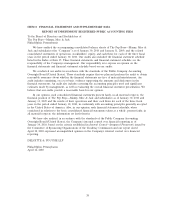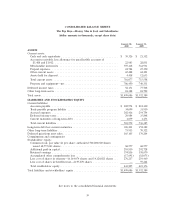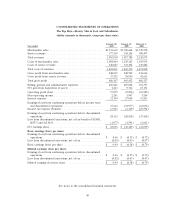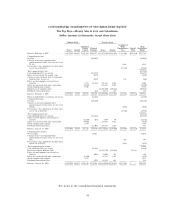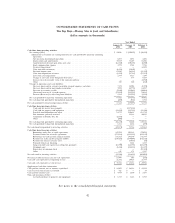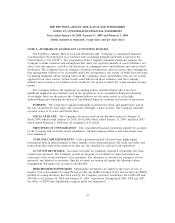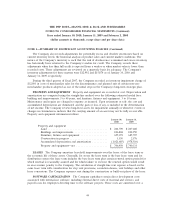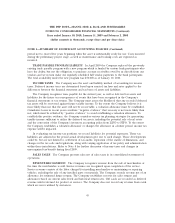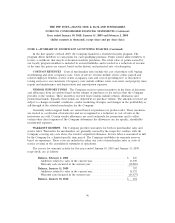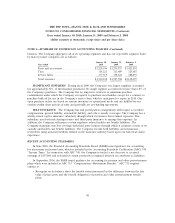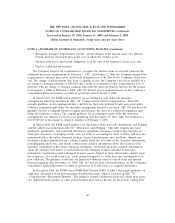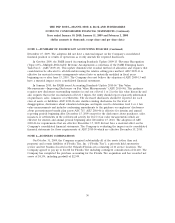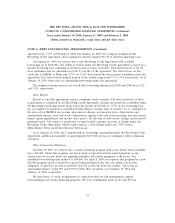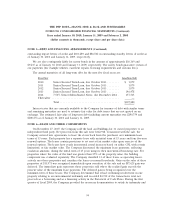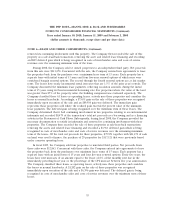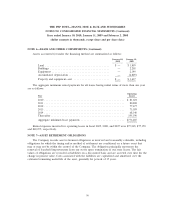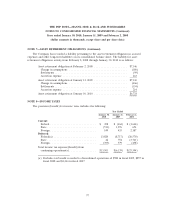Pep Boys 2009 Annual Report Download - page 106
Download and view the complete annual report
Please find page 106 of the 2009 Pep Boys annual report below. You can navigate through the pages in the report by either clicking on the pages listed below, or by using the keyword search tool below to find specific information within the annual report.
THE PEP BOYS—MANNY, MOE & JACK AND SUBSIDIARIES
NOTES TO CONSOLIDATED FINANCIAL STATEMENTS (Continued)
Years ended January 30, 2010, January 31, 2009 and February 2, 2008
(dollar amounts in thousands, except share and per share data)
NOTE 1—SUMMARY OF SIGNIFICANT ACCOUNTING POLICIES (Continued)
business. The Company aggregates all of its operating segments and has one reportable segment. Sales
by major product categories are as follows:
January 30, January 31, February 2,
Year ended 2010 2009 2008
Parts and accessories ................... $1,219,396 $1,255,975 $1,423,891
Tires .............................. 314,223 313,689 325,687
Service labor ......................... 377,319 358,124 388,497
Total revenues ....................... $1,910,938 $1,927,788 $2,138,075
SIGNIFICANT SUPPLIERS During fiscal 2009, the Company’s ten largest suppliers accounted
for approximately 52% of merchandise purchased. No single supplier accounted for more than 18% of
the Company’s purchases. The Company has no long-term contracts or minimum purchase
commitments under which the Company is required to purchase merchandise except for a contract to
purchase bulk oil for use in the Company’s service bays, which is anticipated to expire in 2010. Our
open purchase orders are based on current inventory or operational needs and are fulfilled by our
vendors within short periods of time and generally are not binding agreements.
SELF INSURANCE The Company has risk participation arrangements with respect to workers’
compensation, general liability, automobile liability, and other casualty coverages. The Company has a
wholly owned captive insurance subsidiary through which it reinsures this retained exposure. This
subsidiary uses both risk sharing treaties and third party insurance to manage this exposure. In
addition, the Company self insures certain employee-related health care benefit liabilities. The
Company maintains stop loss coverage with third party insurers through which it reinsures certain of its
casualty and health care benefit liabilities. The Company records both liabilities and reinsurance
receivables using actuarial methods utilized in the insurance industry based upon our historical claims
experience.
RECENT ACCOUNTING STANDARDS
In June 2006, the Financial Accounting Standards Board (FASB) issued guidance for accounting
for uncertainty in income taxes, which is included in the Accounting Standards Codification (ASC) 740
‘‘Income Taxes.’’ In connection with ASC 740, the Company recorded a net decrease to retained
earnings of $155,000 and reclassified certain previously recognized deferred tax attributes as liabilities.
In September 2006, the FASB issued guidance for accounting for pension and other postretirement
plans which were included in ASC 715 ‘‘Compensation—Retirement Benefits.’’ ASC 715 requires
entities to:
• Recognize on its balance sheet the funded status (measured as the difference between the fair
value of plan assets and the benefit obligation) of pension and other postretirement benefit
plans;
48


